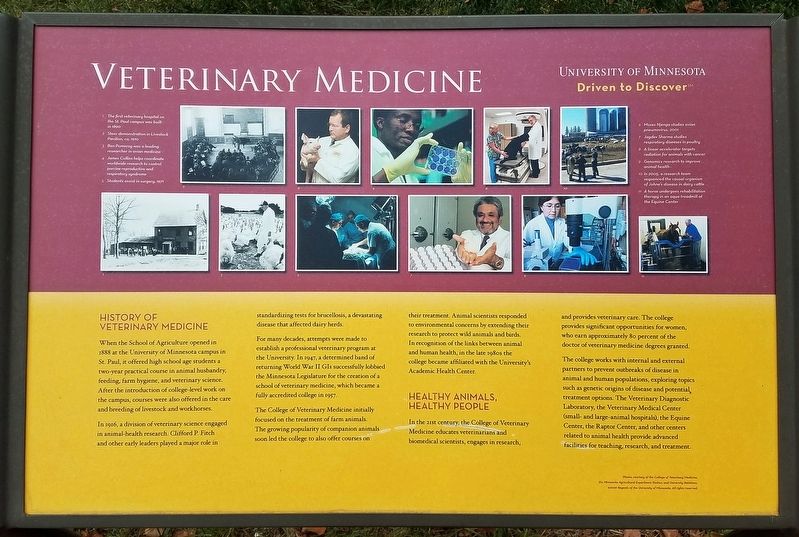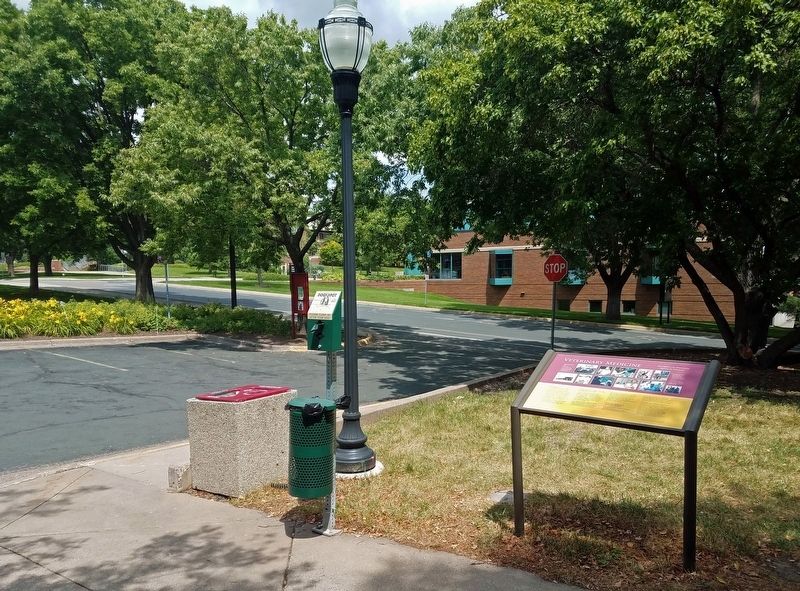Falcon Heights in Ramsey County, Minnesota — The American Midwest (Upper Plains)
Veterinary Medicine
When the School of Agriculture opened in 1888 at the University of Minnesota campus in St. Paul, it offered high school age students a two-year practical course in animal husbandry, feeding, farm hygiene, and veterinary science. After the introduction of college-level work on the campus, courses were also offered in the care and breeding of livestock and workhorses.
In 1916, a division of veterinary science engaged in animal-health research. Clifford P. Fitch and other early leaders played a major role in standardizing tests for brucellosis, a devastating disease that affected dairy herds.
For many decades, attempts were made to establish a professional veterinary program at the University. In 1847, a determined band of returning World War II GIs successfully lobbied the Minnesota Legislature for the creation of a school of veterinary medicine, which became a fully accredited college in 1947.
The College of Veterinary Medicine initially focused on the treatment of farm animals. The growing popularity of companion animals soon led the college to also offer courses on their treatment. Animal scientists responded to environmental concerns by extending their research to protect wild animals and birds. In recognition of the links between animal and human health, in the late 1980s the college became affiliated with the University's Academic Health Center.
Healthy Animals, Healthy People
In the 21st century, the College of Veterinary Medicine educates veterinarians and biomedical scientists, engages in research, and provides veterinary care. The college provides significant opportunities for women, who earn approximately 80 percent of the doctor of veterinary medicine degrees granted.
The college works with internal and external partners to prevent outbreaks of disease in animal and human populations, exploring topics such as genetic origins of disease and potential treatment options. The Veterinary Diagnostic Laboratory, the Veterinary Medical Center (small- and large-animal hospitals), the Equine Center, the Raptor Center, and other centers related to animal health provide advanced facilities for teaching, research, and treatment.
[Captions:]
1. The first veterinary hospital on the St. Paul campus was built in 1890
2. Steer demonstration in Livestock Pavilion, ca. 1910
3. Ben Pomeroy was a leading researcher in avian medicine
4. James Collins helps coordinate worldwide research to control porcine reproductive and respiratory syndrome
5. Students assist in surgery, 1971
6. Moses Njenga studies avian pneumovirus, 2001
7.
Jagdev Sharma studies respiratory diseases in poultry
8. A linear accelerator targets radiation for animals with cancer
9. Genomics research to improve animal health
10. In 2005, a research team sequenced the causal organism of Johne's disease in dairy cattle
11. A horse undergoes rehabilitation therapy in an aqua treadmill at the Equine Center
Erected 2009 by Regents of the University of Minnesota.
Topics. This historical marker is listed in these topic lists: Animals • Education • Science & Medicine. A significant historical year for this entry is 1888.
Location. 44° 58.95′ N, 93° 10.925′ W. Marker is in Falcon Heights, Minnesota, in Ramsey County. Marker is on Gortner Avenue south of Fitch Avenue, on the right when traveling south. Marker is on the St. Paul campus of the University of Minnesota, in front of the Veterinary Medical Center North. Touch for map. Marker is at or near this postal address: 1365 Gortner Avenue, Saint Paul MN 55108, United States of America. Touch for directions.
Other nearby markers. At least 8 other markers are within walking distance of this marker. Old Anatomy Building (within shouting distance of this marker); Extending the U (about 700 feet away, measured in a direct line); The Goldstein Legacy (approx. 0.2 miles away); The St. Paul Campus (approx. ¼ mile away); World War I Memorial Grove (approx. ¼ mile away); Agricultural Excellence (approx. 0.3 miles away); Growing in Minnesota (approx. 0.3 miles away); Al Avila (approx. 0.8 miles away). Touch for a list and map of all markers in Falcon Heights.
Credits. This page was last revised on December 5, 2021. It was originally submitted on December 5, 2021, by McGhiever of Minneapolis, Minnesota. This page has been viewed 110 times since then and 10 times this year. Photos: 1, 2. submitted on December 5, 2021, by McGhiever of Minneapolis, Minnesota. • J. Makali Bruton was the editor who published this page.

